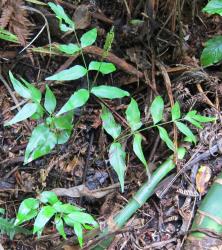Terrestrial or rupestral ferns. Rhizomes erect (NZ) or creeping (not NZ), bearing hairs (NZ) and sometimes non-clathrate scales (not NZ). Fronds hemidimorphic, with fertile and sterile pinnae markedly dimorphic (NZ) or occasionally monomorphic (not NZ), not articulated to rhizome. Stipes hairy (NZ) and occasionally scaly (not NZ). Laminae 1-pinnate to 4-pinnate, anadromous proximally and catadromous distally, herbaceous or coriaceous, hairy (NZ) and occasionally scaly (not NZ). Veins reticulate without free included veinlets (NZ), or free (not NZ). Sporangia limited to the basal pair of skeletonised pinnae, which are held erect on long stalks (NZ), or occasionally borne abaxially on unmodified laminae (not NZ); sporangia in two rows either side of a vein, not in sori, sessile, slightly asymmetrically ovoid or pear-shaped, with the annulus horizontal around the outward-pointing apex, dehiscing by a vertical longitudinal slit; spores maturing ± simultaneously; 32–256 spores per sporangium. Homosporous; spores trilete, with coarse echinate or bacculate ridges, or rarely reticulate, lacking chlorophyll.
Anemia has been monographed by Mickel (2016), and the relationships of 81 species have been analysed on the basis of four chloroplast loci (Labiak et al. 2015), supporting the recognition of a single genus with three subgenera. Only subg. Anemia occurs in New Zealand.
Species of Anemia subg. Anemia are easily recognised by their hemidimorphic fronds. Sporangia are borne only on the basal pair of pinnae, which are highly modified, borne on long stalks and usually held erect. The fertile pinnae are skeletonised, more highly divided than the sterile pinnae, and bear the sessile sporangia in two rows either side of a vein, not in discrete sori.
A genus of about 115 species distributed in America from Texas to Argentina, southern Africa, Madagascar and peninsular India (Kramer 1990); almost 100 species in the Neotropics, 16 in Africa and Madagascar, and one in India (Labiak et al. 2015; Mickel 2016). One casual species in New Zealand.
| Category | Number |
|---|---|
| Exotic: Casual | 1 |
| Total | 1 |
The base chromosome number in Anemia is given as x = 38 by (Smith et al. 2006) with numbers of n = 38, 76, and 114, and 2n = c. 76, 114, and 152 recorded by Kramer (1990).




